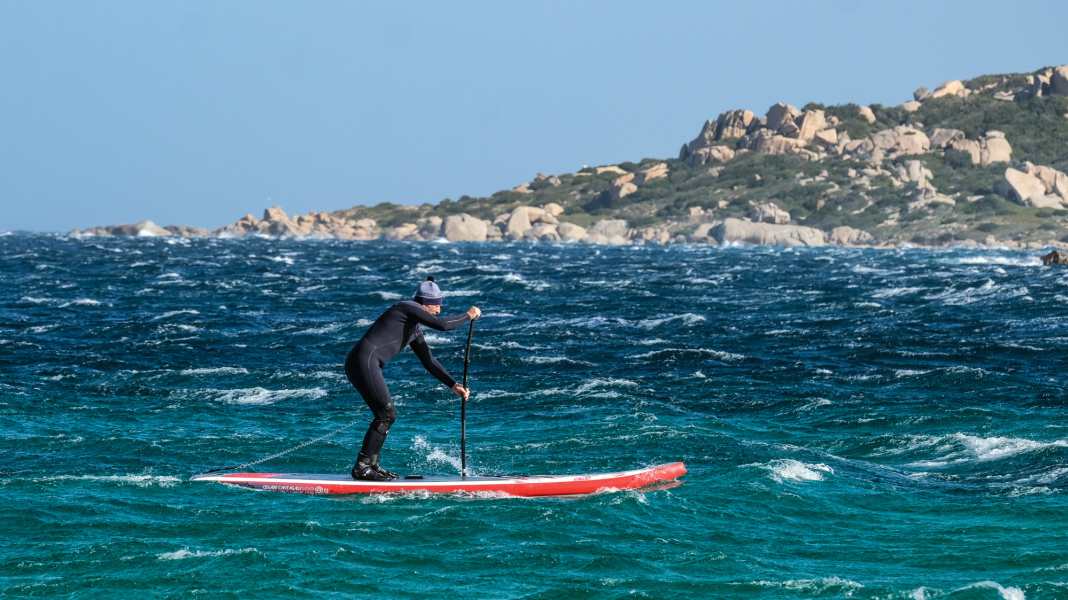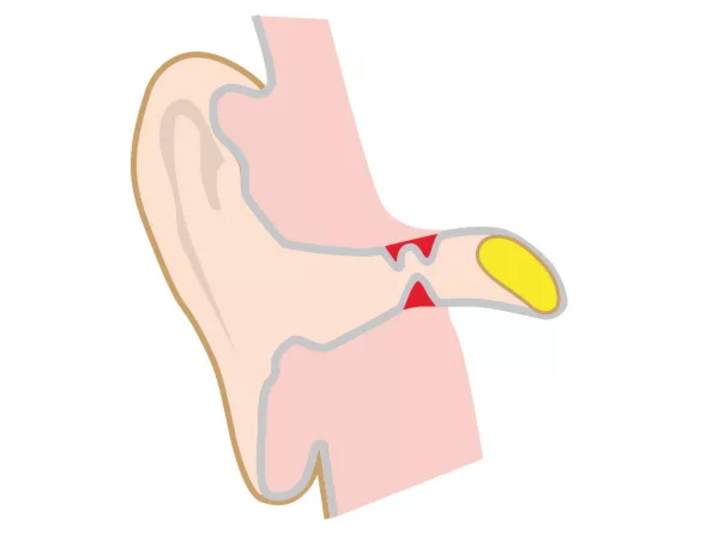
The "surfer's ear" owes its name to a problem that increasingly affects surfers and surfers, but which can also affect stand-up paddlers. The following tips, which our sister magazine surf also interesting for many SUPers.
What is the "Surfer's Ear"?
A narrowing of the ear canal due to abnormal bone growth in the ear canal.
Who gets it?
People who have been practising water sports in cold water/cold wind for years are particularly at risk.
How can you protect yourself from a "surfer's ear"?
Keep warm (bonnet) or reduce water exchange (earplugs).
What are the consequences?
Water drains out less easily, increasing the risk of inflammation. In extreme cases, hearing can decrease noticeably.

Drilling always takes place on Thursdays in Cape Town. When the specialist arrives from Durban, the surfers are queuing up. If a surfer on Melkbos Beach or Sunset Beach casually tells you "I had my ears done last year", he's not talking about an increase in his girlfriend's engine capacity or sail ears. "Surfer's ear" is as common among cold-water surfers as "elbow" is among tennis players. The research immediately leads to ENT specialists on the US west coast - another favourite cold-water surfer's paradise.
But stand-up paddlers, windsurfers and other water sports enthusiasts are also affected. The first generation, who have been out and about frequently and without head protection in cold winter weather for years, are immediately recognised by the ear doctor. The brief, proud moment when you answer the doctor's question "Are you a swimmer?" with "No, I'm a SURFER!" is quickly replaced by the realisation that you have or could have a real problem. But this is not inevitable.
Swimmer's Ear vs. Surfer's Ear
Two phenomena, which are not always uniformly categorised, must be distinguished when it comes to ear problems. The term "swimmer's ear" is sometimes used to describe long-term, bony changes in the ear, but usually only refers to acute inflammation of the external auditory canal. This can happen to anyone if germs from a bath penetrate the vulnerable, thin skin in the ear canal. You don't have to be enthusiastic about the English healthcare system, the mnemonic borrowed from there "nothing smaller than an elbow belongs in the ear" is at least concise, because even cotton buds can damage the skin and make it vulnerable.
The term "surfer's ear" is almost invariably used to describe the long-term narrowing of the ear due to unnatural bone growth in the ear canal (see interview below), as opposed to "swimmer's ear". Unfortunately, the consequences of this are more frequent inflammations because water remains in the ear more often and for longer - with the risk of any ear canal inflammation: Spreading to the middle ear, in the worst case to the inner ear. In this, albeit very rare, case, permanent damage with tinnitus and hearing loss is possible. Inflammation of the ear should therefore always be treated by a doctor if possible, so that an external earache does not become a major construction site. However, prevention is always better than cure when it comes to the "surfer's ear" phenomenon.
The best remedies for "surfer's ear"
Lukas "Luky" Weber, a winter visitor to Cape Town for decades, swears by "Swim Ear Cleanser", a solution that is dripped into the ear after surfing and makes it easier to drain the water. The "surfer's ear" sufferer thus prevents further consequences: "Since I've been using it, I haven't really had any more problems, before I had ear infections all the time".
Thomas Ortmann, perhaps the best-known and most radical bonnet surfer in South Africa's waves, wears the bonnet "mainly as sun protection" in 28-degree air and 15-degree water, but he also struggled with "surfer's ear": "I've been wearing earplugs from the pharmacy for almost eight years, they have three small membranes, because the doctor diagnosed me with 'surfer's ear' back then. 70% left and 60% right. But since then it has almost stopped, I only have a little ear infection now and then. It (the bone growth) stops when you wear earplugs. I also used to have earplugs that still allowed me to hear, but I lost them again.
Not everyone can afford the luxury version, Tom knows: "Many South African surfers simply put Prestik in their ears, it's a sticky thing you can stick things to the wall with, it completely seals the ear. But I don't know if that's so healthy. Others have customised earplugs made for them, but I'm actually happy with the very simple parts from the pharmacy."
Tip from the doctors
Various oils are repeatedly recommended, from "Ballistol", a high-purity gun oil, to medicinal olive oils such as "Earol" or "Auridrop", which are available from pharmacies. These are used to care for and protect the skin in the ear if it has already become tight. "Blow-drying" is a tip along similar lines - the aim is to prevent water remaining in the ear for a long time after blow-drying, allowing potential germs to get a foothold.
The only thing that helps against long-term proliferation is protection from the cold, with a bonnet or plugs that prevent cold water from entering. We have tried out two different types of plugs:
- The "Surfears" impress with their secure fit and, above all, the fact that you can still hear properly with them. A waterproof membrane lets sounds through, so you can communicate well on the beach and the earplugs only have a minor impact when surfing. Info: surfears.com
- The earplugs from "Three Waves" are a silicone mixture for self-moulding, resulting in very comfortable to wear, custom-made earplugs, which, however, strongly dampen hearing. Info: threewaves.com
We are currently trialling other products and will show you the results here once the test phase is complete!
Expert interview: Prof Dr Peter R. Issing
Specialist in ENT medicine, Head of ENT at the Bad Hersfeld Clinic
Professor Issing, is the "surfer's ear" phenomenon also known by this name in medical circles?
Prof Issing: In America this is a common term, in Germany the term "swimmer's ear" is more commonly used. The term "surfer's ear" is certainly also increasingly common, but basically it applies to all people who spend a lot of time in the water: Swimmers or divers, it's not a specific issue that only affects surfers.
Apparently, this phenomenon causes the ear canal to narrow. Can you explain what happens and why the body does this?
The exact mechanism is difficult to explain, all we really know is that it happens. Only the auditory canal is affected. Other bones are also in the water and, as far as I know, they don't change, for example the tibia. It is true that people who spend a lot of time in the water are affected. Obviously the temperature plays a certain role. Cold water is more likely to cause this than warm water. The following happens: In the bony auditory canal - the external auditory canal has two parts, an outer cartilaginous and an inner bony part - the inner part forms so-called exostoses. These are small bony growths, spherical outgrowths of the bone, completely benign and in principle completely harmless. However, if they develop to a certain extent, they narrow the ear canal. Water is less able to escape from the ear canal after bathing or surfing. This can cause more frequent ear canal infections.
Is there any experience as to whether you have to have been in intensive contact with water for a certain number of years for exostoses to form?
I can't answer that quantitatively in the sense that you have to have been in the water for a certain number of hours for so many years, or that you can determine a certain "water dose". But it is certainly something that develops over years. Not in the short term. If you surf for a week on holiday, it's certainly not a problem. But if you do it often, like when you're in the water for hours every day as a swimmer, it can develop.
Among water sports enthusiasts, you often hear complaints from the 35 plus generation. Does this correspond to your experience that it only starts at this age?
Yes, we very rarely have very young people, not 18-year-olds. It doesn't usually affect them.
Do you have any recommendations on how best to protect yourself?
I would use plugs. Because if you assume that the coldness of the water plays a role, then water repellents are of little or no help against the temperature. You should mechanically protect your ear canal from cold water getting in at all.
Alternative recommendations regarding oil and other things are due to something else that is not necessarily directly related to the exostoses. This can also happen to them in warm water, namely ear canal inflammation. They always have germs in the water, even at home in the shower (e.g. Pseudomonas aeruginosa). If the skin is exposed to water for a longer period of time, it becomes brittle and loses some of its protective function, making it easier for germs to penetrate. The recommendation to moisturise the skin with oils or similar products is aimed precisely at preventing external ear canal inflammation.
What role does the "surfer's ear" play in this?
If they already have exostoses, i.e. these constrictions, then they certainly have a slightly higher risk of developing an inflammation of the ear canal because it is harder for the water to get out. Some people also advise blow-drying the ear. These germs love moisture and if you keep the ear dry, the risk is lower.
Ear canal care products include "Vaxol", which contains a medicinal olive oil. Or "Otodolor soft". This is a glycerine-based preparation - in the form of drops that can be dripped into the ear canal. Ointments are not recommended as applying them can be problematic: For example, they can be manipulated with cotton buds without visual control, the skin in the ear canal is additionally irritated and they encourage the development of ear canal inflammation. Small cracks form through which bacteria can enter. Another practical tip: The ear canal - the bony and cartilaginous part - is not completely straight at the junction. If you pull the pinna backwards and upwards, you can even out this kink a little and any water that may be in the ear can come out more easily.
If the exostoses are already there, what do you do?
Exostoses are often signalled by inflammation of the ear canal or hearing loss when the ear no longer cleans itself of earwax.
The only possible treatment is surgical removal. This is actually an unproblematic procedure. The exostoses are drilled away. However, the problem is that everything is very tight and the extremely thin skin over the protrusions in the ear canal has to be loosened. They then hollow out these "mountains" and remove them with the intention of preserving the skin. This is important because otherwise scarring can occur afterwards. Of course, you don't want that. The skin is used to precisely cover the exposed bone at the end. The surgeon has to pay attention to this, otherwise it is not a spectacular procedure.

